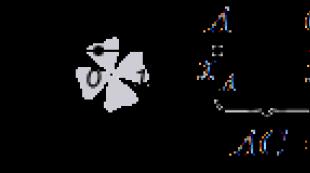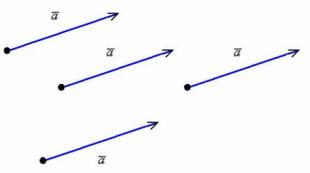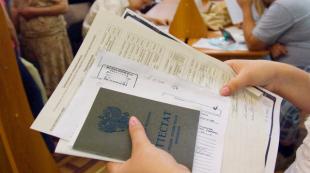The mechanism of palatopharyngeal closure in congenital clefts. Palato-pharyngeal insufficiency and ways of its elimination. Methods for diagnosing palatopharyngeal insufficiency
Classes begin on the 21st day after the operation. Work on this direction is carried out in parallel with the correction of physiological and phonation respiration.
In the postoperative period, when the anatomical and physiological conditions for the formation of correct speech are created, the activation of the palatine curtain and the development of the mobility of the muscles of the palatopharyngeal ring are of particular importance. The solution of these problems is facilitated by:
soft and hard palate massage;
gymnastics of the soft palate and posterior pharyngeal wall.
The main goals of soft palate massage are:
scar tissue stretching
increased performance of contractile muscles,
reduction of muscle atrophy,
improvement of local blood circulation,
activation of healing processes.
Attention should be paid to the question of the timing of speech therapy massage. Soft palate massage is performed for all children who apply within 6-8 months after palate plasty. It is at this time that the process of scarring occurs and the massage performs its main function: it contributes to the formation of elasticity and mobility of the muscles of the palatine curtain. Children with good mobility of the soft palate, who applied for speech therapy help more than 8 months after uranoplasty, massage is not performed. In working with such children, as a rule, only active gymnastics of the soft palate is used.
- 1. Before starting the massage, the speech therapist must thoroughly disinfect his hands by wiping them with cotton wool moistened with a special preparation.
- 2. The duration of the massage in one area should not exceed 3 minutes.
- 3. Massage is not performed if the child has a febrile or subfebrile state, the presence of herpetic or pustular rashes, convulsive readiness.
- 3. Complex of hard and soft palate massage
thumb to make stroking movements along the hard palate from the front teeth and back; gradually the area of influence increases and reaches the soft palate;
with the thumb to make transverse stroking movements along the hard and soft palate from left to right and vice versa;
with the thumb to make circular stroking and rubbing movements on the hard and soft palate from left to right and vice versa; movements begin to be performed from the upper lateral teeth, gradually moving from the hard palate to the soft one;
make similar movements from the incisors to the pharynx and vice versa;
with the middle finger, make stroking, pressing, rubbing movements along and across the scar from the incisors to the pharynx and vice versa;
make stroking, kneading, stretching movements along the soft palate with the middle finger from the central part to the lateral edges;
tap the index or middle finger on the hard and soft palate.
In addition to massage, children are recommended to carry out special exercises that promote the development of the mobility of the muscles of the soft palate. The set of exercises aimed at restoring the functional activity of the muscles of the soft palate includes passive, passive-active and active gymnastics. These exercises help to create a favorable background for the formation of accurate and coordinated work of the muscles of the palatopharyngeal ring, which are necessary for the development of a full-fledged voice.
Passive gymnastics of the soft palate.
Passive gymnastics is so named because the movements of the organs of articulation are performed by a speech therapist.
drip liquid from a pipette onto the root of the tongue, while the child's head is somewhat tilted back. This exercise stimulates the elevation of the soft palate. When performing it, juice can be used instead of water;
lightly press on the root of the tongue with a spatula; performing this exercise requires some caution, as sudden movements can cause a gag reflex.
Active gymnastics of the soft palate.
Passive gymnastics is combined with special exercises to activate the veil of the palate:
gargle with your head thrown back in small sips. This exercise produces the greatest effect if, when performing it, instead of water, use a heavy liquid such as kefir, thin yogurt or jelly;
cough voluntarily; in this case, coughing is not performed at the level of the larynx, as is done when there are unpleasant sensations in the throat, but at the level of the soft palate. These actions cause a reflex contraction of the muscles of the posterior pharyngeal wall and contribute to the emergence of a full-fledged palatopharyngeal closure. First, coughing is done with the tongue hanging out. The air flow is directed into the oral cavity. Thus, while performing the task, in addition to activating the soft palate, children train in the development of a directed air jet;
imitate yawning. Exercise improves blood circulation in the brain and enhances the outflow of venous blood;
exaggerate vowels A-E-O on a hard attack. This increases the pressure in the oral cavity and decreases nasal emission;
slowly, silently pronounce the vowels A-E-O, while trying to observe a clear articulation;
sing vowels with a gradual strengthening and weakening of the voice.
Let us give an example of an exercise for activating the muscles of the palatopharyngeal ring in a game situation “Masha (Bear, elephant, etc.) wants to sleep”, which can be used in working with children preschool age. To do this, you need several dolls or soft toys depicting various animals. The speech therapist together with the child chooses which toy they will put to bed.
L .: When evening comes, it becomes dark outside and all the toys should go to bed. So Mishka wants to sleep (shows how he yawns), and so the dog also wants to sleep and yawns (shows). And now you show how they yawn.
L .: And what about the Mashenka doll? She is a little capricious and wants to have a song sung to her before going to bed. Let's sing her a lullaby
Bye-bye, bye-bye, fall asleep quickly! A-A-A.
The child listens attentively to the song, and then repeats the vowel sounds in a singsong voice.
L .: Look, Masha is already closing her eyes, yawning. Show me how she does it. Well, now she's definitely asleep.
Such exercises, in addition to activating the muscles of the palatopharyngeal ring, contribute to the formation of a long directed oral exhalation in a child during phonation.
ANATOMICAL AND PHYSIOLOGICAL ROLE OF THE PALATO-PHARYNTERAL APPARATUS.
The palate is normally a formation that separates the cavities of the mouth, nose and pharynx. It consists of a hard and soft palate. The hard palate has a bone base. In front and on the sides it is framed by the alveolar process of the upper jaw with teeth, and behind it is the soft palate. The hard palate is covered with a mucous membrane, the surface of which behind the alveoli has an increased tactile sensitivity. The height and configuration of the hard palate affect resonance,
The soft palate is the posterior part of the septum between the nasal and oral cavities. The soft palate itself is a muscular formation. The anterior third of it is practically immobile, the middle one is most actively involved in speech, and the posterior one - in tension and swallowing. As it rises, the soft palate lengthens. At the same time, there is a thinning of its anterior third and a thickening of the posterior one. The soft palate is anatomically and functionally connected with the pharynx. Together they form the palatopharyngeal mechanism involved in respiration, swallowing and speech. When breathing, the soft palate is lowered and partially covers the opening between the pharynx and the oral cavity. When swallowing, the soft palate stretches, rises and approaches the back wall of the pharynx, which accordingly moves towards and comes into contact with the palate. At the same time, other muscles of the tongue, the lateral walls of the pharynx, and its upper constrictor contract.
In the process of speech, a very rapid muscle contraction is constantly repeated, which brings the soft palate closer to the back of the pharynx in an upward and backward direction. When raised, it comes into contact with the Passavan roller. However, regarding the indispensable participation of the Passavan roller in the palatopharyngeal closure, there are conflicting opinions in the literature. The soft palate moves up and down very quickly during speech: the time of opening or closing the nasopharynx ranges from 0.01 to 1 second. The degree of raising it depends on the fluency of speech, as well as on the phonemes that are currently being pronounced. The maximum raising of the palate is observed when pronouncing sounds a and c, and its greatest tension is observed when And. This voltage is slightly reduced when at and significantly on oh ah, uh
In turn, the volume of the pharyngeal cavity changes with the phonation of different vowels. The pharyngeal cavity occupies the largest volume when pronouncing sounds and And y, the smallest at a and intermediate between them at e and o.
Those. during the normal functioning of the speech apparatus, the ratio of resonation of the oral and nasal cavities is not the same when pronouncing oral and nasal sounds. When pronouncing mouth sounds, the palatine curtain rises. At the same time, a thickening is formed on the back wall of the pharynx - Passavan's roller. As a result, a palatopharyngeal closure (palato-pharyngeal closure) is formed, which prevents the passage of an air stream into the nasal cavity. The density of closure of the palatine curtain and the muscles of the posterior pharyngeal wall is different when pronouncing sounds. The air jet can pass through the nasal cavity. This is facilitated by the formation of a bow in the oral cavity during the pronunciation of nasal sounds. So, when pronouncing the sound M, a bow of the lips is formed, and when pronouncing the sound H, a bow of the tip of the tongue with the neck of the upper incisors is formed. Nasal sounds according to the method of formation are stop-passing.
When blowing, swallowing, whistling, the soft palate rises even higher than during phonation, and closes the nasopharynx, while the pharynx narrows. However, the mechanisms of palatopharyngeal closure during speech do not speech activity different.
There is also a functional relationship between the soft palate and the larynx. It is expressed in the fact that the slightest change in the position of the palatine curtain affects the position of the vocal folds. And the increase in tone in the larynx entails a higher rise in the soft palate.
Violation of the interaction between the oral and nasal cavities leads to a change in the timbre of the voice, nasalization (Nasus - Latin, nose). Violation of the timbre of the voice in rhinolalia manifests itself in hypernasalization (increased nasalization during the pronunciation of oral sounds) and in hyponasalization (reduced nasalization of nasal sounds).
Depending on the nature of the violation of the timbre of the voice (hypernasalization or hyponasalization), as well as the nature of the violation of the ratio of the oral and nasal cavity, open, closed and mixed rhinolalia are distinguished.
Rhinolalia - violation of the timbre of the voice and sound pronunciation, due to anatomical and physiological defects of the speech apparatus.
Atrhinolalia the mechanism of articulation, phonation and voice formation has significant deviations from the norm and is due to a violation of the participation of the nasal and oropharyngeal resonators. With normal phonation in a person during the pronunciation of all speech sounds, except for nasal ones, the nasopharyngeal and nasal cavities are separated from the pharyngeal and oral cavities.
Forms of rhinolalia
Depending on the nature of the dysfunction of the palatopharyngeal closure, various forms of rhinolalia are distinguished.
Closed rhinolalia characterized by reduced physiological nasal resonance during the pronunciation of speech sounds.
Characteristic:
Violation of the pronunciation of nasal consonant sounds (m, m", n, n" sound like mouth b, b", d, d");
Violation of the pronunciation of vowels (it acquires an unnatural, dead shade);
Causes of closed rhinolalia most often are organic changes in the nasal space or functional disorders of the palatopharyngeal closure. Organic changes are caused by painful phenomena, as a result of which the patency of the nose decreases and nasal breathing is difficult.
Anterior closed rhinolalia occurs with chronic hypertrophy of the nasal mucosa, mainly the posterior sections of the lower concha, with polyps in the nasal cavity, with a curvature of the nasal septum and with tumors of the nasal cavity.
Posterior closed rhinolalia in children, it is most often the result of large adenoid growths, occasionally nasopharyngeal polyps, fibromas, or other nasopharyngeal tumors.
Functional closed rhinolalia common in children, but not always correctly recognized. It is characterized by the fact that it occurs with good conductivity of the nasal cavity and unimpaired nasal breathing. With a functional closed rhinolalia, the timbre of nasal and vowel sounds may be more disturbed than with an organic one. The reason is that the soft palate during phonation and pronunciation of nasal sounds rises above the norm and closes the access to the nasopharynx for sound waves. Similar phenomena are more often observed in neurotic disorders in children.
Open rhinolalia .
Characteristic:
Violation of the timbre of vowel sounds;
Violation of the timbre of some consonants. When pronouncing hissing sounds and fricatives f, v, x, a hoarse sound is added that occurs in the nasal cavity. Explosive sounds n, b, d, t, k and r, as well as sonorous l and r sound unclear, since the air pressure necessary for their accurate pronunciation cannot be formed in the oral cavity.
Open rhinolalia can be organic and functional.
Organic open rhinolalia may be congenital or acquired.
Most frequentcause congenital form is the splitting of the soft and hard palate.
Acquired open rhinolalia It is formed with trauma to the oral and nasal cavities or as a result of acquired paralysis of the soft palate.
Causes of functional open rhinolalia may be different. For example, it occurs during phonation in children with sluggish articulation of the soft palate. The functional open form manifests itself in hysteria, sometimes as an independent defect, sometimes as an imitative one.
One of the functional forms - the habitual open rhinolalia, observed, for example, after the removal of large adenoid growths, occurs as a result of a long-term restriction of the mobility of the soft palate.
Functional examination with open rhinolalia does not reveal organic changes in the hard or soft palate. A sign of a functional open rhinolalia is also the fact that the pronunciation of only vowels is usually disturbed, while when pronouncing consonants, the palatal-pharyngeal closure is good and nasalization does not occur.
The prognosis for functional open rhinolalia is more favorable than for organic. Nasal timbre disappears after phoniatric exercises, and pronunciation disorders are eliminated by the usual methods used for dyslalia.
Rhinolalia due to congenital nonunion of the lip and palate , represents a serious problem for speech therapy and a number of medical sciences (surgical dentistry, orthodontics, otolaryngology, medical genetics, etc.). Cleft lip and palate are the most common and severe congenital malformation.
There are the followingtypes of crevices :
1) cleft lip and alveolar process
2) clefts of the hard and soft palate;
3) clefts of the upper lip, alveolar process and palate - one and two-sided;
4) submucosal (submucosal) cleft palate. With cleft lip and palate, all sounds acquire a nasal or nasal tone, which grossly violates the intelligibility of speech.
Impact on the physical development of the child
As a result of this defect in children in the process of their physical development, serious functional disorders occur.
In children with congenital nonunion of the lip and palate, the act of sucking is very difficult. It presents particular difficulties in children with a through cleft lip and palate, and with bilateral through clefts, this act is generally impossible.
Difficult feeding leads to a weakening of vitality, and the child becomes susceptible to various diseases. To the greatest extent, children with clefts are predisposed to catarrh of the upper respiratory tract, bronchitis, pneumonia, rickets, and anemia.
Often, such children have pathological changes in the ENT organs: curvature of the nasal septum, deformities of the wings of the nose, adenoids, hypertrophy (enlargement) of the tonsils. Often they have inflammatory processes in the nasal region. The inflammatory process can move from the mucous membrane of the nose and pharynx to the Eustachian tubes and cause inflammation of the middle ear. Frequent otitis, often taking a chronic course, cause hearing loss. Approximately 60-70% of children with cleft palate have hearing loss of varying degrees (usually in one ear) - from a slight decrease that does not interfere with speech perception to significant hearing loss.
Deviations in the anatomical structure of the lip and palate are closely related to underdevelopment of the upper jaw and malocclusion with a defective arrangement of teeth.
Numerous functional disorders caused by a defect in the structure of the lip and palate require constant medical supervision.
In our country, conditions have been created for complex treatment in specialized centers at the Research Institute of Traumatology, at the departments of surgical dentistry, as well as in other institutions where a lot of medical and preventive work is carried out.
Doctors of various specialties observe children and jointly adopt a comprehensive treatment plan.
During the first years of a child's life, the leading role belongs to the pediatrician, who manages the feeding and daily routine of the baby, carries out prevention and treatment, and, if necessary, recommends outpatient or inpatient treatment.
Surgery to restore the upper lip (cheiloplasty) is recommended in the first year of a child's life; often it is produced in maternity hospitals in the first days after birth.
In cases of cleft palate, the orthodontist uses various devices, including an obturator, which facilitate nutrition and create conditions for the development of speech in the preoperative period. The otolaryngologist identifies and treats all painful changes in the ear, nasal cavities, nasopharynx and larynx and prepares children for surgery.
With deviations in mental development and the presence of pronounced neurotic reactions of the child, a neuropathologist consults.
The palate repair operation (uranoplasty) is performed in most cases at preschool age.
As of mental development Children with cleft palate fall into three categories:
1) children with normal mental development;
2) children with mental retardation;
3) children with olegophrenia (of varying degrees). On neurological examination, signs of severe focal brain damage, as a rule, are not observed. Some children have individual neurological microsigns. Children are more likely to have functional impairments. nervous system, sometimes significantly pronounced psychogenic reactions, increased excitability.
Congenital cleft palate has a negative impact on the development of the child's speech.
Cleft lip and palate play a different role in the formation of speech underdevelopment. It depends on the size and shape of the anatomical defect.
Typical is the imposition of additional noises on the nasalized sounds, such as breathing, snoring, larynx, etc. There is a specific violation of the timbre of the voice and sound production.
To prevent the passage of food through the nose, children from a very early age acquire the habit of lifting the back of the tongue to block the passage into the nasal cavity. This position of the tongue becomes habitual and also changes the articulation of sounds.
During speech, children usually open their mouths a little and raise the back of the tongue higher than required. The tip of the tongue therefore does not move fully. Such a habit impairs the quality of speech, since with a high position of the jaw and tongue, the oral cavity takes on a shape that contributes to the entry of air into the nose, which increases nasality.
When trying to pronounce the sounds p, b, f, c, a child with rhinolalia uses "his" methods. The sounds are replaced by a pharyngeal click, which very peculiarly characterizes the speech of a child with a severe form of rhinolalia. A specific click, reminiscent of the sound of a valve, is formed when the epiglottis touches the back of the tongue.
A direct correspondence between the size of the palatine defect and the degree of speech distortion has not been established. This is due to large individual differences in the configuration of the nasal and oral cavities in children, the ratio of resonant cavities and compensatory techniques that each child uses to increase the intelligibility of his speech. In addition, the intelligibility of speech depends on the age and individual psychological characteristics of children.
Speech therapy sessions with a child must be started in the preoperative period in order to prevent the occurrence of serious changes in the functioning of the speech organs. At this stage, the activity of the soft palate is prepared, the position of the root of the tongue is normalized, the muscular activity of the lips is enhanced, and a directed oral exhalation is developed. All this, taken together, creates favorable conditions for increasing the efficiency of the operation and subsequent correction. 15-20 days after the operation, special exercises are repeated; but now the main goal of the classes is to develop the mobility of the soft palate.
The study of the speech activity of children suffering from rhinolalia shows that inferior anatomical and physiological conditions of speech formation, the limitation of the motor component of speech lead not only to the abnormal development of its sound side, but in some cases to a deeper systemic violation of all its components.
With the age of the child, indicators speech development worsen (compared to the indicators of normally speaking children), the structure of the defect is complicated by the violation of various forms of written speech.
Early correction of deviations in speech development in children with rhinolalia has an extremely important social and psychological and pedagogical significance for the normalization of speech, the prevention of difficulties in learning and choosing a profession.
To understand the mechanism of occurrence of these anomalies, it is necessary to study the process of formation of the lip and palate.
The formation of the lip and palate begins at the 5-10th week of intrauterine life; the primary oral cavity is divided into two sections:
oral cavity and nasal cavity.
This is due to the formation of lamellar protrusions of the palatine processes on the inner surfaces of the maxillary processes. At the beginning eighth week the edges of the palatine processes are directed obliquely downward and lie along the bottom of the oral cavity, on the sides of the tongue. The lower jaw is enlarged. The tongue descends into this space, making it possible to move the palatine processes from a vertical to a horizontal position.
In the end second month During the life of the embryo, the edges of the palatine processes begin to connect with each other, begins in the anterior sections and gradually spreads backwards. The septum of the oral bay is the rudiment of the hard and soft palate. It separates the final oral cavity from the nasal cavity. At the same time, the nasal septum grows, which fuses with the palate and divides the nasal cavity into the right and left nasal chambers.
by the 11th week, a lip and a hard palate are formed,
and by the end of the 12th week fragments of the soft palate grow together with each other. The state of the lip and palate in the embryo at certain stages of development is the same as in case of nonunions observed in the clinic: from a through bilateral fissured defect of the lip, alveolar process and palate to nonunion of only the soft palate and even only the uvula or hidden nonunion of the lip. Conventionally, this condition of the lip or palate can be called a physiological cleft. Under the influence of one or more of the listed etiological factors, the fusion of the edges of the "physiological clefts" is delayed, which leads to congenital non-union of the lip, palate, or a combination of them.
One of the pathogenetic factors of non-union of the halves of the palate, obviously, is the pressure of the tongue, the size of which, as a result of growth discorrelation, turned out to be larger than usual. Such a discrepancy may occur on the basis of hormonal metabolic disorders in the mother's body.
Topic 3. Causes and mechanisms of disorders in rhinolalia
.Causes of rhinolalia.
Types and forms of congenital clefts.
Classification of rhinolalia.
The mechanism of occurrence of speech disorders in rhinolalia.
Mechanisms of impaired speech breathing, voice formation and sound pronunciation.
Etiology
The etiological factors of anomalies of the human body, including the maxillofacial region, are divided into exogenous and endogenous.
TO exogenous factors relate:
1) physical (mechanical and thermal effects; external and internal ionizing radiation);
2) chemical (hypoxia, malnutrition of the mother during critical periods of embryo development, lack of vitamins (retinol, tocopherol acetate, thiamine, riboflavin, pyridoxine, cyanocobalamin), as well as essential amino acids and iodine in the mother's diet; hormonal discrepancies. Exposure to teratogenic poisons that cause fetal hypoxia and deformity in it, the influence of chemical compounds that mimic the action of ionizing radiation, such as mustard gas;
H) biological (rubella measles, mumps, shingles, bacteria and their toxins);
4) mental (cause hyperadrenalemia).
TO endogenous factors belong to:
1) predisposition to pathological heredity (there is no gene carrying a hereditary predisposition of nonunion)
2) biological inferiority of cells;
H) the influence of age and gender.
In the anamnesis of patients and their parents, it is often possible to establish the following factors with which the appearance of birth defects has to be associated: infectious diseases suffered by the mother during pregnancy; toxicosis, spontaneous and artificial abortions; severe physical injury at 8–12 weeks of gestation; diseases of the genital area; severe mental trauma of the mother; late birth; maternal malnutrition.
Types and forms of congenital clefts
Congenital malformations of the palate include:
1) congenital cleft palate and lips
2) submucosal clefts;
3) congenital underdevelopment of the palate;
4) congenital asymmetry of the face with palate deformation.
Most often in practice there are cleft lips and palate. Forms of palatine clefts are extremely diverse, but they all lead to impaired speech.
Cleft lips. Distinguish between partial and complete cleft lip. The anatomical structure and size of the lips in children and adults vary considerably.
A normally developed upper lip has the following anatomical components:
1) filter 2) two columns; H) red border; 4) median tubercle; 5) the line, or arc, of Cupid. This is the name of the line that delimits the red border and the skin of the upper lip.
When treating a child with a congenital lip defect, the surgeon must recreate all of its listed elements.
Classification. In accordance with clinical and anatomical signs, congenital defects of the upper lip are divided into several groups.
1. nonunion of the upper lip is divided into lateral - unilateral(constituting about 82%), bilateral.
2. on partial(when non-union has spread only to the red border or, simultaneously with the red border, there is non-union of the lower part of the skin of the lip
And full- within the entire height of the lip, as a result of which the wing of the nose is usually turned due to nonunion of the base of the nostril
Cracks in the sky. The palate is normally a formation that separates the cavities of the mouth, nose and pharynx. It consists of a hard and soft palate. Solid has a bone base. In front and on the sides it is framed by the alveolar process of the upper jaw with teeth, and behind it is the soft palate. The hard palate is covered with a mucous membrane, the surface of which behind the alveoli has an increased tactile sensitivity. The height and configuration of the hard palate affect resonance.
The soft palate is the posterior part of the septum between the nasal and oral cavities. The soft palate represents a muscular formation. Its anterior third is practically immobile, the middle one is most actively involved in speech, and the posterior one - in tension and swallowing. As it rises, the soft palate lengthens. At the same time, there is a thinning of its anterior third and a thickening of the posterior one.
The soft palate is anatomically and functionally connected with the pharynx, the palatopharyngeal mechanism is involved in breathing, swallowing and speech.
When breathing, the soft palate is lowered and partially covers the opening between the pharynx and the oral cavity. When swallowing, the soft palate stretches, rises and approaches the back wall of the pharynx, which accordingly moves towards and comes into contact with the palate. At the same time, other muscles contract: tongue, lateral walls of the pharynx, its upper constrictor.
When blowing, swallowing, whistling, the soft palate rises even higher than during phonation, and closes the nasopharynx, while the pharynx narrows.
Definition of rhinolalia
This is a violation of sound pronunciation and voice timbre due to anatomical and physiological defects of the speech apparatus. The pronunciation of both consonants (voiced and voiceless) and vowels suffers. Not only sound pronunciation suffers, but also the voice. The presence of a nasal tone of voice distinguishes rhinolalia from dyslalia, which is characterized only by a violation of sound pronunciation.
Depending on the nature of damage to the speech apparatus, the nature of the anatomical defect and dysfunction of the palatopharyngeal closure, rhinolalia manifests itself in 3 types - open, closed and mixed. According to the etiology, it can be organic and functional.
Causes and mechanism of speech impairment in rhinolalia: modern approaches.
Pathological features of the structure and activity of the speech apparatus cause diverse deviations in the development of not only the sound side of speech, various structural components of speech suffer to varying degrees.
In oral speech, impoverishment and abnormal conditions for the course of the prelinguistic development of children with rhinolalia are noted. In connection with the violation of the speech-motor periphery, the child is deprived of intensive babbling, articulatory "game", thereby impoverishing the stage of preparatory adjustment of the speech apparatus.
Not only the articulation of sounds suffers, but also the development of prosodic elements of speech.
There is a late onset of speech, a significant time interval between the appearance of the first syllables, words and phrases already in the early period, that is, a distorted path of speech development as a whole begins. To the greatest extent, the defect manifests itself in the violation of its phonetic side.
The most significant manifestations of the defectiveness of the phonetic design of oral speech are the violations of all oral speech sounds due to the connection of a nasal resonator and changes in the aerodynamic conditions of phonation. Sounds become nasal.
In addition, the specific coloring of some consonant sounds (often posterior palatine) is revealed due to the connection of the pharyngeal resonator.
There are also phenomena of additional articulation in the cavity of the larynx, which gives speech a kind of "clicking" overtone.
Many other more specific defects are also revealed. For example: omitting the initial consonant ("ak, am" - so, there); neutralization of dental sounds according to the method of formation, replacement of explosive sounds with fricatives; whistling background when pronouncing hissing sounds or vice versa; lack of vibrant R or sound replacement s with a strong exhalation; the imposition of additional noise on nasalized sounds (hissing, whistling, breathing, snoring, larynx, etc.); movement of articulation to more rear zones.
The speech of a child with rhinolalia is generally unintelligible.
Thus, the mechanism of violation in open rhinolalia is determined by the following:
1) the absence of the palatopharyngeal shutter and, as a result, a violation of the opposition of sounds on the basis of oral-nasal;
2) a change in the place and method of articulation of most sounds due to defects in the hard and soft palate, lethargy of the tip of the tongue, lips, retraction of the tongue deep into the oral cavity, high position of the root of the tongue, participation in the articulation of the muscles of the pharynx and larynx.
Features of the letter. Features of pronunciation of children with rhinolalia lead to distortion and unformed phonemic system of the language.
Secondarily conditioned features of the perception of speech sounds are the main obstacle to mastering the correct letter.
The relationship of writing disorders with defects in the articulatory apparatus has a variety of manifestations. If by the time of training a child with rhinolalia has mastered intelligible speech, he can clearly pronounce most sounds mother tongue and only a slight nasal tinge remains in his speech, then the development of the sound analysis necessary for literacy is proceeding successfully. However, as soon as additional obstacles to normal speech development arise in a child with rhinolalia, specific writing disorders appear.
Dysgraphic errors that are observed in the written work of children with cleft palate are varied.
Specific for rhinolalia are substitutions P, b on m, t, d on the n and reverse substitutions n - d, t, m - b, p, due to the lack of phonological opposition of the corresponding sounds in oral speech, omissions, substitutions, the use of sticky vowels are revealed, substitutions and mixtures of hissing-sibilant are common, difficulties in using affricates, sound c is replaced by s, mixing of voiced and deaf consonants is characteristic, errors are not uncommon for missing one letter from the confluence, sound l is replaced r, r on the l.
The degree of writing impairment depends on a number of factors: the depth of the defect in the articulatory apparatus, personality characteristics and compensatory abilities of the child, the nature and timing of speech therapy, and the influence of the speech environment.
general characteristics rhinolalia.
Rhinolalia(from the Greek nose + speech) - violation
voice timbre and sound pronunciation, due to anatomical and physiological
speech defects.
Rhinolalia in its directions differs from dyslalia by the presence of an altered
nasalized
(lat. nose) voice timbre.
With rhinolalia, articulation of sounds, phonation differ significantly from the norm.
With normal phonation during the pronunciation of all speech sounds, except for nasal ones, in humans
there is a separation of the nasopharyngeal and nasal cavities from the pharyngeal and oral cavities.
These cavities are separated by palatopharyngeal closure caused by contraction of the muscles of the soft
palate, lateral and posterior walls of the pharynx.
Simultaneously with the movement of the soft palate during phonation, a thickening of the posterior pharyngeal wall occurs.
(Passavan roller), which contributes to the contact of the back surface of the soft
palate with posterior pharyngeal wall.
During speech, the soft palate continuously descends and rises to different heights depending on
from the spoken sounds and the rate of speech. The strength of the palatopharyngeal closure depends on
spoken sounds. It is smaller for vowels than for consonants. Weakest
palatopharyngeal closure is observed with a consonant in
, the strongest - at from
,
usually 6-7 times stronger than with but.
During normal pronunciation of nasal sounds mm"
,n, n"
air jet
freely penetrates into the space of the nasal resonator.
Depending on the nature of the dysfunction of the palatopharyngeal closure, various
forms of rhinolalia. The presence of congenital cleft palate deeply affects the entire development of the child: it
children are sickly, somatically weakened, they often have a decrease
hearing. With rhinolalia, a speech defect may be accompanied by developmental disabilities
higher mental functions. These patients are characterized by
features of personality development and activity formation.
The speech defect of the rhinolalic from birth is due to a number of reasons.
First of all, ensuring the vital functions of respiration and nutrition leads to
specific position of the body of the tongue (with an excessively raised root). Such
the position of the tongue leads to a violation of its functionality, on the one hand
side, and to defective compensation of the violation - on the other (during speech in
articulation involves the muscles of the face, forehead, there are diverse synkinesis).
With rhinolalia, the formation of atypical specific breathing, the development
hypernasalization and articulation defects of sounds.
In the picture of a speech disorder, defective sound pronunciation is the leading one, secondarily it can
suffer from the lexical and grammatical structure of speech, phonemic hearing, written
speech. Correction of the defect is carried out by means of medical, speech therapy and psychological-pedagogical
impact.









